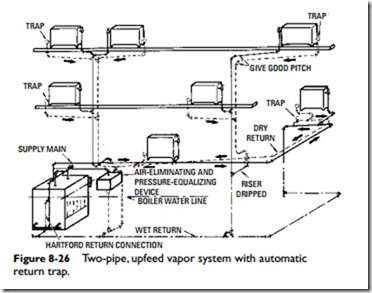Vacuum Steam Heating Systems
A vacuum heating system is one that operates with steam at pressures less than that of the atmosphere. The object of such systems is to take advantage of low working temperatures of the steam at these low pressures, giving a mild form of heat such as is obtained with hot-water heating systems. Vacuum systems such as these, which operate at all times at pressures less than atmospheric, should not be confused with the combined atmospheric and vacuum systems described in the next section. There are distinct design differences between the two systems.
A distinction should be made between a vacuum system and a subatmospheric system. The latter differs from an ordinary vacuum system in that it maintains a controlled partial vacuum on both the supply and return sides of the system instead of only on the return side. In the vacuum system, steam pressure above that of the atmosphere exists in the supply mains and heat-emitting units practically at all times. The subatmospheric system is characterized by atmospheric pressure or higher existing in the steam supply piping and heat-emitting units only during severe weather (Figures 8-27 and 8-28).
There are a number of different methods of classifying vacuum systems (e.g., one-pipe or two-pipe and vacuum pressure or subat- mospheric). For the purposes of this chapter they will be classified according to the type of vacuum: natural vacuum systems and mechanical vacuum systems.


